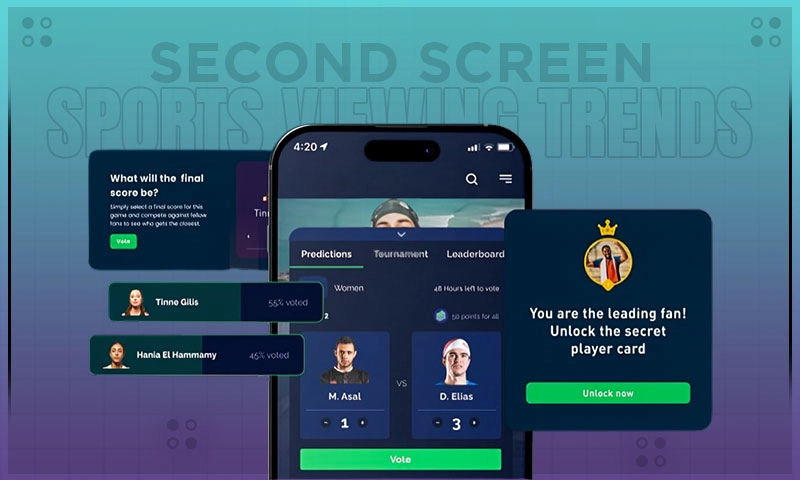
As smartphones and social media platforms became popular, sports broadcasting started competing with mobile viewership growth and second-screen viewing. Social media has impacted how fans watch sports by being an alternative platform to consume sports content.
Platforms such as X, Facebook, Instagram, and TikTok have immediate access to live sports information and highlight reels. These platforms are now becoming the primary second screen for most fans during live events.
Simultaneous Viewership
Dual screening or simultaneous viewing is making fans gain extra viewing insight and experience in conjunction with the main broadcast on TV. Over 80% of millennials and Gen Z sports betting fans use their smartphones while watching live games on TV.
The second-screen culture is encouraged through the interactive information that flows even as the games are broadcasted. Whether it is live commentary, player updates, or following multiple games at the same time, simultaneous viewing will not threaten the viewership of the first screen. On the contrary, second-screen culture is enhancing the engagement and content of first-screen viewing.
Live Sports Betting
The incorporation of social media platforms and live sports has enabled viewers to consume information without delay. This has forced sports bodies to provide appropriate information about live sporting events with the ever-growing social media phenomenon.
As a result, online sports betting on platforms like Betway has become possible. Sports betting fans can now engage in dual-screening as they bet on live events of a game.
Second-Screen Engagements
Second-screen engagement has become very important in keeping fans glued to the broadcast on the first screen. Betway fans can now follow live commentary from online sports journalists, comment on the progress of the game, provide personal opinions, and interact with other viewers.
The second-screen culture is complementing live sports viewership by providing a heightened viewing experience. For example, sports fans can share ‘memes’ regarding a team or a player on X, and in a matter of seconds, the joke is spread rapidly amongst users on multiple platforms. Just like the way fans in the stadium share moments as the game progresses, second-screens ensure those watching virtually also share such moments.
Social Media
Social media is the force behind the rise of second-screen culture. Social media platforms such as X, Facebook, and YouTube have managed to enable creative and exclusive side-shows that run simultaneously with TV broadcasts. These shows not only engage fans on the second screen but also compel them to watch the action on the first screen.
Even before a game starts broadcasting on the first screen, fans are able to keep the conversation of the game active on social media. Days before the matchday arrives, fans can share their opinions and predictions about the players and the game. The sports teams can also share team updates on social media and reach almost every sports fan in the world.
Second Screens, First Impressions
Second-screen culture isn’t just a background habit anymore. It’s how a growing number of fans experience sports in real time. And while the content is rich, highlight clips, polls, and commentary, the real pull is in how personal and hands-on the experience has become.
Fans aren’t just scrolling. They’re chiming in. Whether it’s debating a ref’s call, posting predictions before a corner kick, or jumping into a team poll mid-match, second screens offer a way to stay locked into the action. It turns watching into participating. That sense of involvement is what keeps people engaged long after kickoff.
Broadcasters and leagues know this. You’ll see hashtags flashed on screen, live fan reactions included in broadcasts, and even players responding online before the final whistle. It’s no longer a split between TV and social feeds. The two feed off each other. Watching a match now feels more like being in a digital stadium, full of shared energy and quick reactions.
Depending on the sport, the second-screen experience shifts. Cricket fans might zero in on live delivery stats, while football fans track passes, player heatmaps, or even behind-the-scenes videos from the bench. For sports betting fans, that same second screen becomes a strategic tool. Odds shift, injuries happen, and moments unfold fast. Platforms like Betway make it easy to act quickly, especially when you’re already tuned in.
This layer of real-time involvement changes the tone completely. It doesn’t matter if you’re on your couch, riding the train, or catching the last minutes in a café. That second screen keeps you plugged in and part of the bigger conversation.
Final Thoughts
It is plausible to assume that more people will become focused on second-screens because of the live interaction. As social media advances, phones or tablets will become the primary watching and interacting screen for live sports. What started as a companion to the main event is quickly becoming the main event itself.
